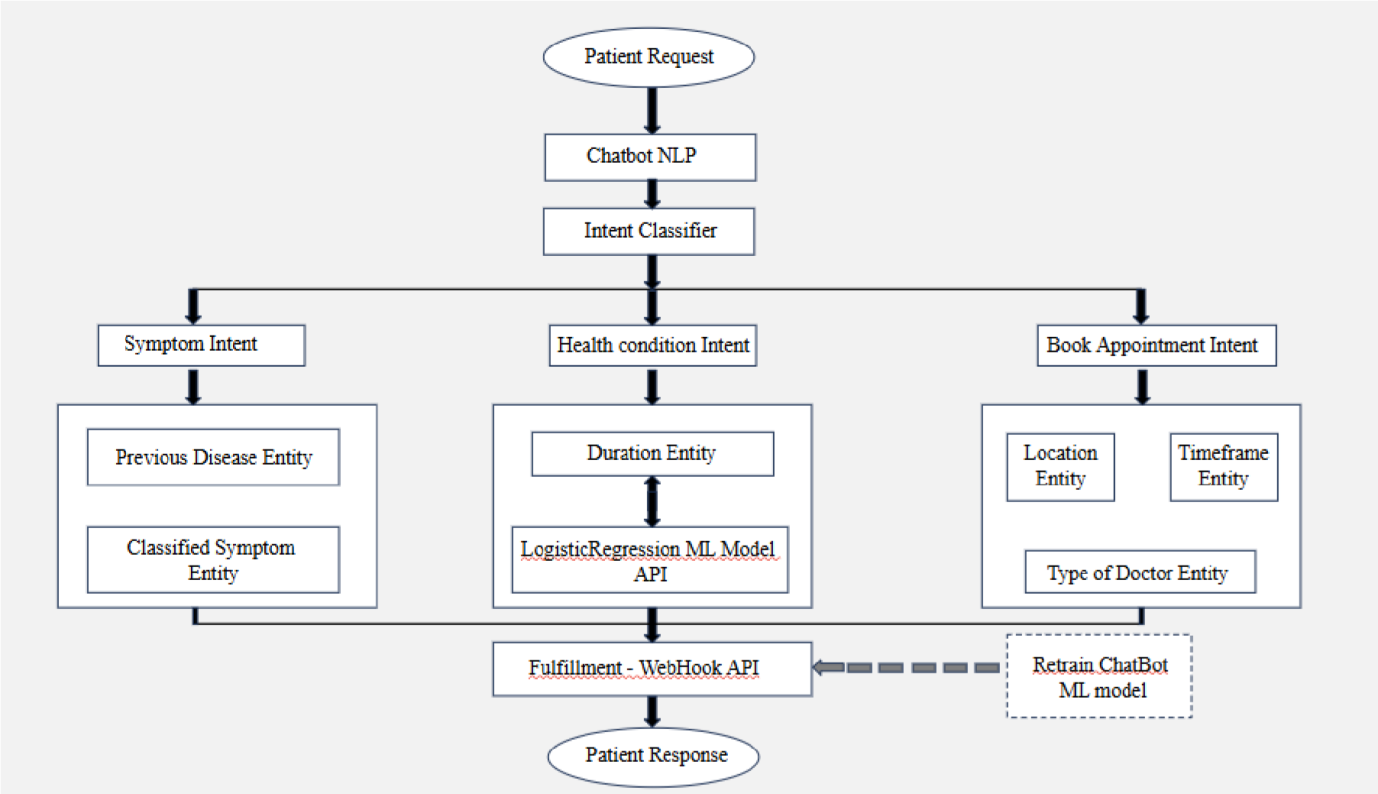Ijraset Journal For Research in Applied Science and Engineering Technology
- Home / Ijraset
- On This Page
- Abstract
- Introduction
- Conclusion
- References
- Copyright
DocBot AI as Your Personal Health Assistant: Bridging the Gap in Consultations Revolutionizing Healthcare Using Natural Language Processing and Artificial Intelligence
Authors: Prof. Neha Nandanwar, Karra Mohit, Patik Bankar, Pratham Dofe , Kalpik Ramteke
DOI Link: https://doi.org/10.22214/ijraset.2024.64278
Certificate: View Certificate
Abstract
The DocBot Chat Bot/AI system is a novel solution to the challenge of acquiring accurate and personalized health information. By utilizing cutting-edge artificial intelligence (AI) algorithms and natural language processing (NLP) methods, the DocBot system creates an engaging and intuitive interface that lets people convey their health concerns and get personalized advice. This study provides an in-depth assessment of the DocBot system, stressing its key features, AI algorithms, advantages, difficulties, and potential applications. To improve healthcare communication and encourage well-informed decision-making, it is important to highlight DocBot\'s transformative potential in providing users with accurate and trustworthy health knowledge.
Introduction
I. INTRODUCTION
The contemporary healthcare landscape is marked by the exponential growth of information and the consequent challenges individuals face in accessing accurate and personalized health-related advice. Despite the proliferation of resources, the gap between the complexity of health data and its effective dissemination to the general populace remains a significant concern. In this context, the development of the "DocBot Chat Bot/AI" system emerges as a timely and innovative solution to bridge this gap.
The "DocBot Chat Bot/AI" technology, which combines cutting-edge artificial intelligence (AI) and natural language processing (NLP) techniques to give users thorough insights into their health concerns, is a trailblazing development in the healthcare industry. This AI-powered platform not only allows users to communicate about their health difficulties in a natural conversational style, but it also provides a detailed analysis of the symptoms and concerns provided. DocBot hopes to empower customers with precise and individualized information about their health conditions, along with appropriate recommendations for additional action, by utilizing the power of data processing and AI-driven decision-making. The DocBot system is intended to address a wide range of health issues, from general symptoms to mental health inquiries, in response to the increasing demand for trustworthy and easily accessible health information. By utilizing advanced AI algorithms, the system ensures personalized solutions for each user, delivering tailored advice and preventive steps for a variety of health concerns. Informed decision-making and proactive health management are made easier by the DocBot Chat Bot/AI system, which functions as an interactive platform that connects people with health information. It promotes a culture of health literacy and involvement by providing users with thorough insights into the nature of health problems, their possible causes, and evidence-based treatment options. This paper aims to provide an in-depth exploration of the architecture, functionality, and significance of the DocBot system, shedding light on its role in transforming the landscape of healthcare information dissemination. Through a detailed examination of its capabilities, limitations, and potential applications, this research emphasizes the transformative potential of AI-driven healthcare solutions in promoting inclusive and user-centric healthcare services. By empowering users with accurate and reliable health-related information, the DocBot system stands as a testament to the transformative potential of advanced technology in facilitating informed decision-making and enhancing overall health awareness.
II. LITERATURE REVIEW
A. Integration of AI in Healthcare
In recent years, burgeoning interest and substantial progress have been witnessed in the application of artificial intelligence (AI) within healthcare settings. AI technologies, particularly machine learning and deep learning algorithms, have been increasingly leveraged to tackle a variety of challenges in medical diagnostics, treatment planning, and patient management.
B. Accurate Diagnosis
In the domain of medical imaging, AI has demonstrated remarkable capabilities in interpreting complex visual data. Studies by Esteva and Ardila exemplify AI's proficiency in detecting anomalies in mammograms and lung cancer screenings, often achieving diagnostic accuracies comparable to or even surpassing those of trained radiologists. These advancements not only expedite the diagnostic process but also contribute to earlier disease detection and improved patient outcomes.
C. Real-Time Insights
Clinical decision support systems (CDSS) powered by AI have emerged as invaluable tools for healthcare providers. These systems integrate vast amounts of patient data from electronic health records (EHRs) and other sources, offering evidence-based recommendations for diagnosis and treatment. Research by Shickel highlights how AI-driven CDSS enhances decision-making by providing real-time insights and predictive analytics, thereby optimizing clinical workflows and reducing medical errors.
D. The First-Step to Personalized Medicine
In personalized medicine, AI plays a pivotal role in tailoring treatment strategies to individual patient profiles. By analyzing genetic data, biomarkers, and patient histories, AI algorithms can predict disease progression, recommend personalized therapies, and anticipate adverse reactions to medications (Obermeyer). This personalized approach not only improves treatment efficacy but also minimizes unnecessary interventions, ultimately enhancing patient care and satisfaction.
E. Improved Efficiencies
Furthermore, AI's application extends beyond diagnostics and treatment to include operational efficiencies within healthcare systems. AI-driven algorithms optimize resource allocation, predict patient admission rates, and streamline administrative processes, thereby reducing healthcare costs and improving overall system performance (Obermeyer).
So, the integration of AI into healthcare represents a paradigm shift towards more precise, efficient, and personalized medical care. While significant progress has been made, ongoing research and collaborative efforts are essential to address existing challenges and unlock the full potential of AI in revolutionizing healthcare delivery.
III. RESEARCH GAP
Even though the development of AI/ML in healthcare has advanced significantly, there are still some important research gap that need to be addressed.
A. Limitations in Complex Diagnosis
The system may encounter challenges in accurately diagnosing complex or rare health conditions that require comprehensive clinical evaluation and specialized medical expertise. If a complex problem arises, diagnosing it will be a difficult task.
B. Dependence on User-Provided Data
DocBot relies on the accuracy and completeness of the data provided by users, which may lead to potential inaccuracies or misinterpretations if the users fail to provide comprehensive and precise information.
C. Ethical and Privacy Concerns
The system must adhere to stringent data privacy and ethical guidelines to ensure the confidentiality and security of user-provided health information, addressing potential concerns related to data protection and user privacy.
D. Lack of Human Interaction and Empathy
DocBot's automated nature may result in a lack of human empathy and emotional support, potentially impacting user satisfaction and the overall user experience, especially in cases requiring compassionate and empathetic communication.
IV. PROBLEM STATEMENT
There are a lot of rural areas where people don't have the medical guidance or facilities. The majority of deaths due to diseases that occur in these areas are because the early-stage symptoms of the major diseases are ignored and not diagnosed sooner which results in the development of the disease resulting in costly medical treatments and sometimes death.
V. OBJECTIVES
The primary objective of the "DocBot Chat Bot/AI" system is to revolutionize the accessibility and understanding of health information for individuals from diverse backgrounds and varying levels of health literacy.
This system is specifically designed to cater to the following key objectives:
- Comprehensive Health Issue Analysis: The DocBot system aims to conduct an in-depth analysis of user-provided health issues through intelligent data processing and natural language understanding, thereby facilitating a comprehensive understanding of the presented symptoms and concerns.
- Tailored Health Information Dissemination: By leveraging advanced AI algorithms, DocBot intends to provide tailored and easily comprehensible health-related information to users, enabling them to gain insights into the nature and implications of their health problems in a user-friendly and accessible format.
- Personalized Solution Recommendations: DocBot seeks to offer personalized recommendations and potential solutions for the identified health issues, considering various factors such as medical history, symptom severity, and any potential risk factors, to guide users towards informed decision-making and suitable courses of action.
- Empowering User Engagement: The system aims to foster active engagement and participation from users by promoting a conversational and interactive platform where individuals can freely articulate their health concerns, seek information, and receive guidance in a supportive and informative environment.
- Enhanced Health Literacy: DocBot strives to contribute to the enhancement of health literacy by providing accurate and reliable health-related information, educating users about various health concerns, and promoting a deeper understanding of the implications and management of different health issues.
VI. METHODOLOGY
The "DocBot Chat Bot/AI" system operates as a sophisticated software application, integrating advanced AI algorithms and natural language processing techniques to facilitate comprehensive health issue analysis and resolution. While there is no physical circuitry, the system architecture can be represented as follows:
The system primarily comprises the following key components:
A. User Interface (UI)
This component enables users to interact with the system, input their health concerns, and receive relevant information and recommendations in a user-friendly and conversational manner.
B. Natural Language Processing (NLP) Module
The NLP module is responsible for processing and understanding user inputs, extracting relevant data, and facilitating seamless communication between users and the DocBot system.
C. Data Processing and Analysis Unit
This unit incorporates advanced AI algorithms to analyze the provided health data, identify potential health issues, and generate informative insights and recommendations based on the analyzed data.
D. Knowledge Base and Database
The system's knowledge base and database store a vast repository of medical information, including symptoms, diagnoses, treatments, and related health literature, enabling the system to provide accurate and up-to-date information to users.
E. Response Generation and Delivery
This component is responsible for generating user-friendly responses based on the analyzed data and delivering them to the users in a clear and understandable format, facilitating effective communication and knowledge dissemination.
VII. FLOWCHART

Conclusion
In DocBot AI, By offering prompt and tailored responses to user queries, the system has facilitated informed decision-making and proactive health management among users, fostering a culture of health literacy and engagement. The continuous learning mechanism embedded within the system has further contributed to its ongoing refinement and optimization, ensuring the delivery of accurate and up-to-date information to users in real-time. As evidenced by its myriad advantages, including its accessibility, personalized guidance, and continuous learning capabilities, the DocBot system stands as a testament to the transformative potential of AI-driven healthcare solutions in promoting inclusive and user-centric healthcare services. Moving forward, the envisioned future scope, encompassing advanced diagnostic capabilities, multilingual support, and integration with wearable devices, among other developments, promises to further amplify the impact and reach of the DocBot system, positioning it as a pioneering force in the realm of intelligent healthcare communication and support.
References
[1] Ayushi Sharma, Rakesh Kumar, “Artificial Intelligence in Health Care Sector and Future Scope”, Publisher: IEEE, 20 April 2023. https://ieeexplore.ieee.org/document/10100220 [2] Omar Alia, Wiem Abdelbakib, Anup Shresthac, Ersin Elbasib. “A systematic literature review of artificial intelligence in the healthcare sector: Benefits, challenges, methodologies, and functionalities”. ScienceDirect (2023). https://www.sciencedirect.com/science/article/pii/ [3] Secinaro, S., Calandra, D., Secinaro, A. et al.\" The role of artificial intelligence in healthcare: a structured literature review.\" BMC Med Inform Decis Mak 21, 125 (2021). https://bmcmedinformdecismak.biomedcentral.com/articles [4] World Health Organization. (2021). \"Global Strategy for Digital Health 2020-2025.\" Retrieved from: https://www.who.int/global-digital-health-strategy. [5] Doyle OM, Leavitt N, Rigg JA. Finding undiagnosed patients with hepatitis C infection: an application of artificial intelligence to patient claims data. Sci Rep. 2020;10(1):10521. https://www.nature.com/articles/s41598-020-67013-6 [6] National Institutes of Health. (2019). \"Guidelines for Data Privacy and Security in Healthcare Systems.\" Retrieved from https://www.nih.gov/data-privacy-guidelines.
Copyright
Copyright © 2024 Prof. Neha Nandanwar, Karra Mohit, Patik Bankar, Pratham Dofe , Kalpik Ramteke. This is an open access article distributed under the Creative Commons Attribution License, which permits unrestricted use, distribution, and reproduction in any medium, provided the original work is properly cited.

Download Paper
Paper Id : IJRASET64278
Publish Date : 2024-09-19
ISSN : 2321-9653
Publisher Name : IJRASET
DOI Link : Click Here
 Submit Paper Online
Submit Paper Online

